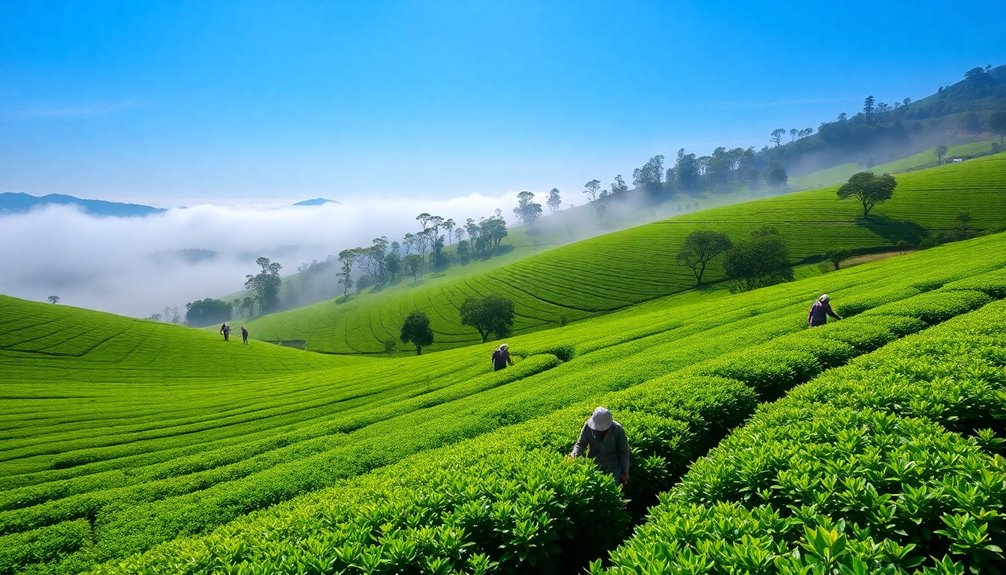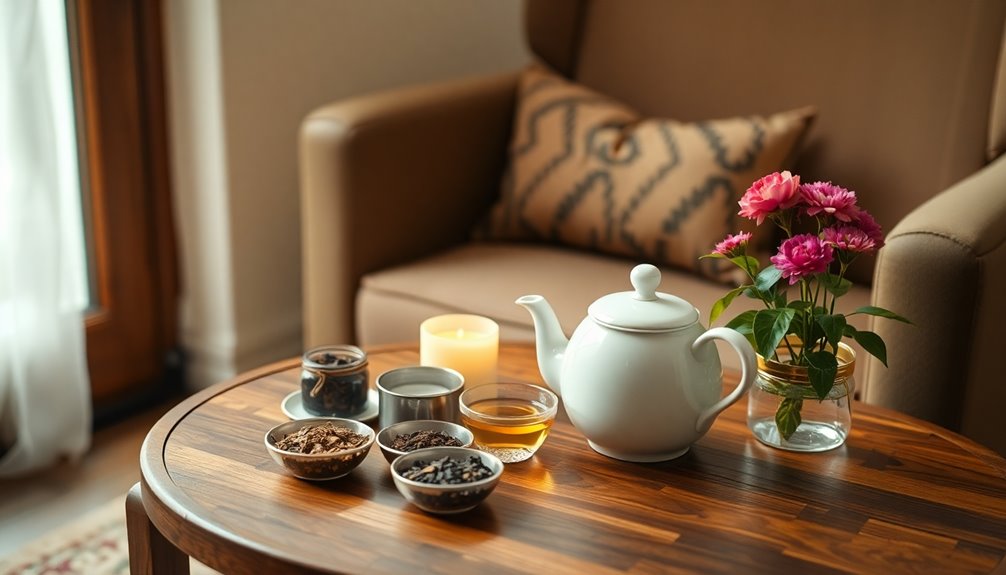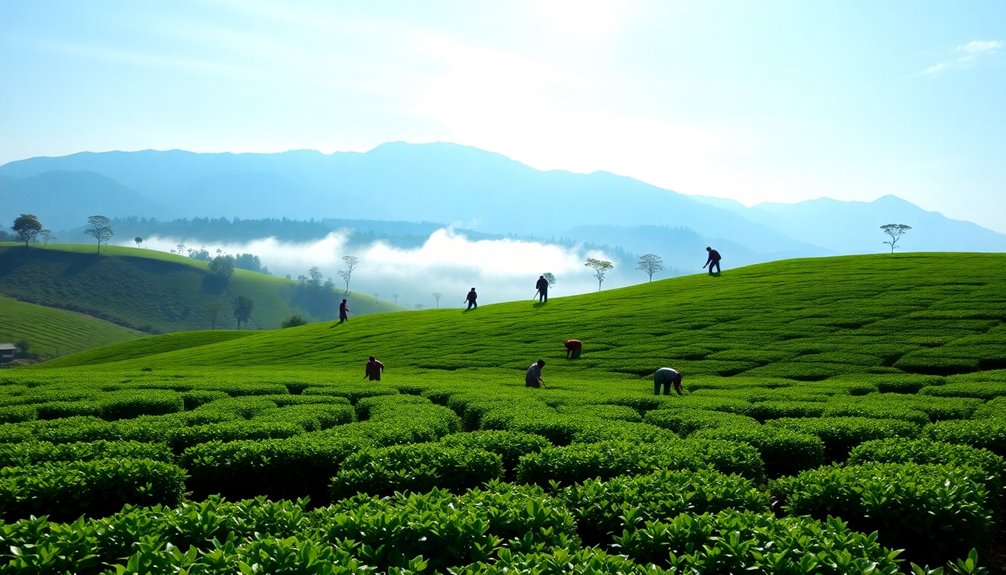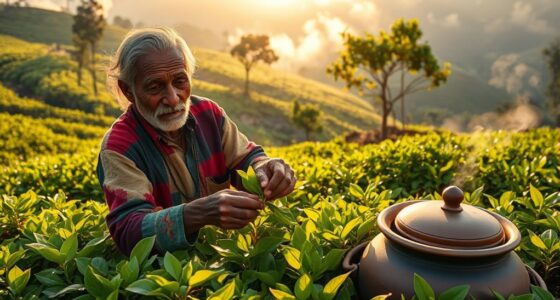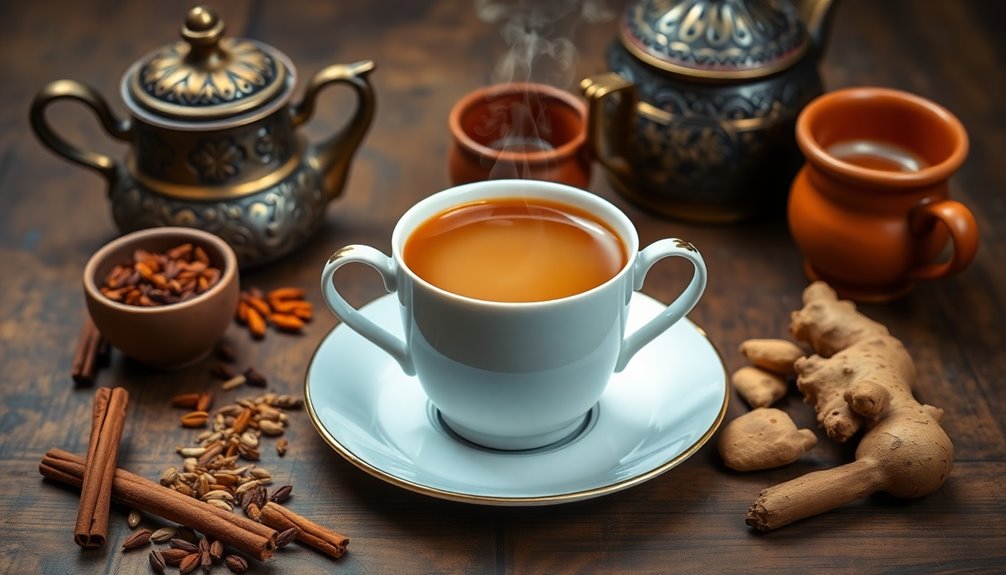You can visit amazing tea plantations in India that are perfect for family tours today! Here are some fantastic spots:
- Darjeeling: Famous for its light, floral tea.
- Assam: The largest tea area, with a fun Tea Festival in November.
- Munnar: Home to India's first tea museum and beautiful views.
- Kolukkumalai: Known as the highest tea plantation, offering unique flavors.
These places offer guided tours where you can taste delicious tea and learn about growing. It's a joyful adventure waiting for you! Discover more fun facts and tips about your tea adventure!
Key Takeaways
- Darjeeling: Experience the renowned light and floral teas while enjoying guided tours of the picturesque estates from March to November.
- Assam: Visit the largest tea-growing region, famous for robust black teas, especially during the annual Tea Festival in November.
- Munnar: Explore India's first tea museum and learn about sustainable tea practices while touring scenic plantations from August to May.
- Kolukkumalai: Discover possibly the highest tea plantation in the world, known for its unique aroma and taste, with guided tours available.
- Tea Tasting Opportunities: Engage in interactive tea tastings and meet tea growers in various estates across India for a deeper understanding of tea culture.
Introduction

India boasts some of the most celebrated tea plantations in the world, each offering distinct flavors and breathtaking landscapes. When you visit places like Darjeeling, Assam, and Munnar, you can dive into the amazing world of tea!
- Darjeeling: Known for its light, floral tea, it contributes 25% of India's tea production. You can enjoy guided tours at estates like Happy Valley and Tumsong Chiabari.
- Assam: Often called the "Tea Capital of the World," Assam has the largest tea-growing area in India. Don't miss the annual Tea Festival in November or a visit to Banyan Grove on Gatoonga Tea Estate!
- Munnar: Here, you'll find stunning tea plantations and India's first tea museum. It's a great spot to learn about sustainable tea practices.
And if you're feeling adventurous, check out Kolukkumalai, possibly the highest tea plantation in the world. The aroma and taste are unique, thanks to traditional processing methods.
With guided tours, tea tasting, and the chance to meet dedicated tea growers, you'll create unforgettable memories exploring these incredible tea estates!
Tea's Cultural Significance in India
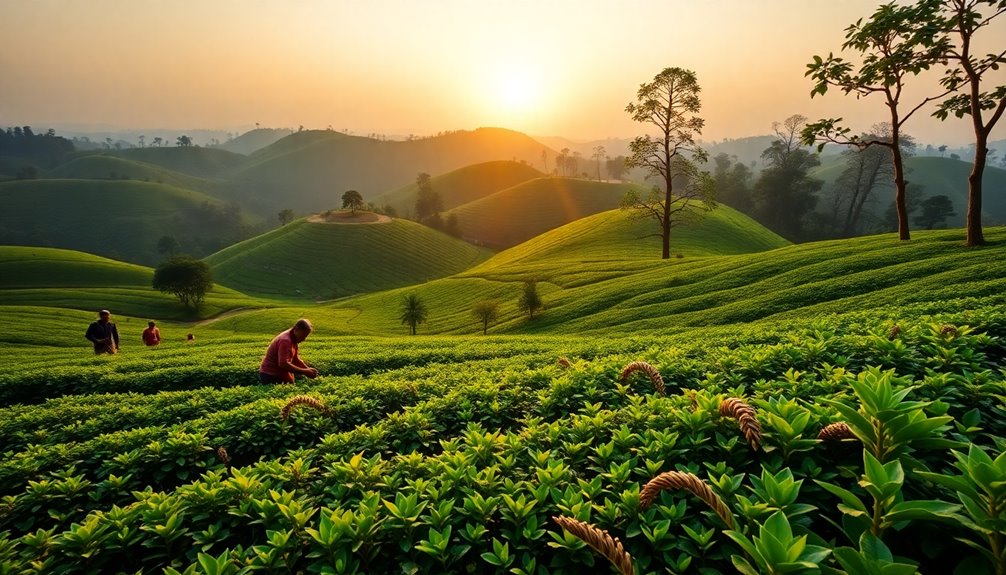
Embracing tea culture in India reveals a rich tapestry of traditions and social connections. Tea isn't just a drink; it's a symbol of hospitality that brings people together. When you visit Assam or Darjeeling, you'll experience how tea plays a central role in social gatherings, from the bustling streets to serene homes.
One delightful way to enjoy tea is through masala chai, a spicy blend of black tea, milk, and aromatic spices. Each region has its unique twist, making every sip a journey through local flavors.
Festivals like the Tea Festival in Assam celebrate this beloved beverage, showcasing lively music, dance, and local craftsmanship. These events promote tea production and offer a fantastic way to learn about the culture.
The British colonial era shaped India's tea culture, introducing organized plantations and making tea a cornerstone of Indian identity. It's fascinating to see how these historical ties continue to thrive.
Tea Cultivation Regions' Diversity
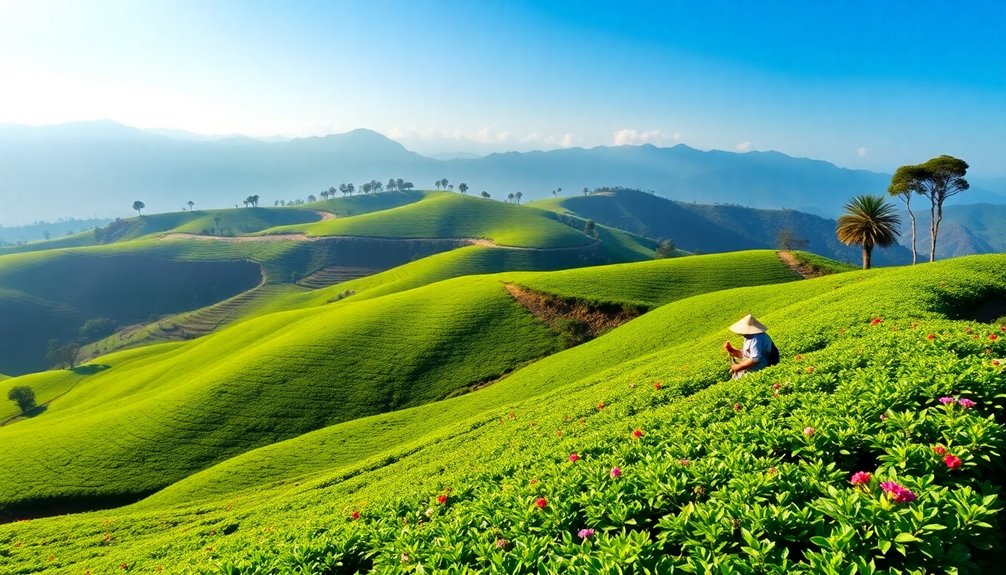
Across the diverse landscapes of India, tea cultivation thrives in distinct regions, each offering unique varieties and flavors shaped by their specific climates and elevations.
When you visit Assam, the largest tea-producing region, you'll discover robust black teas that are perfect for your morning cup. The best time to experience the tea harvest here is from mid-May to the end of June.
Next, head to Darjeeling, often called the "Champagne of Teas." Here, you can enjoy light-colored, floral-smelling teas, especially delightful from March to November.
Don't miss Munnar in Kerala, where expansive tea plantations await you. You can even explore India's first tea museum while enjoying lush landscapes, best visited from August to May.
Heritage Tea Varieties to Explore
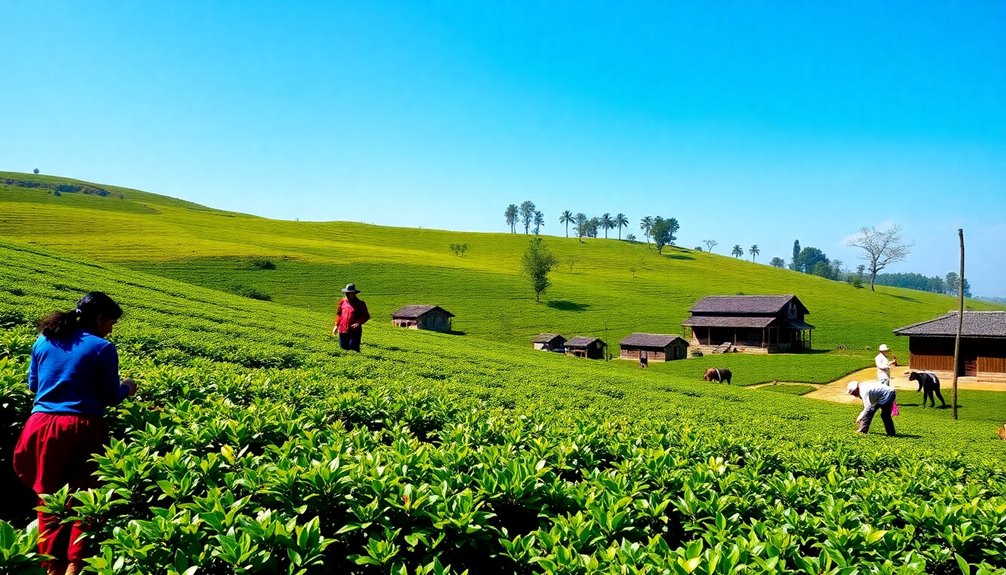
When exploring the rich tapestry of tea heritage in India, you'll find a treasure trove of unique varieties that reflect centuries of cultivation and tradition.
Dive into the world of heritage tea varieties, starting with the famous Darjeeling tea. Known for its light color and floral aroma, it's a delight to sip, especially from March to November.
Next, head to Assam tea, celebrated for its bold and malty flavor. Jorhat, the "Tea Capital of the World," is the perfect spot to enjoy this variety from mid-May to late June.
Don't miss out on Nilgiri tea, which offers a dark, aromatic brew best enjoyed from late November to mid-February.
If you're up for an adventure, visit the Makaibari Tea Estate in Darjeeling. This historic plantation produces black, green, white, and oolong teas, showcasing exceptional tea processing methods.
For an educational spin, check out Munnar's Tea Museum, where you can learn about heritage tea varieties and enjoy tea tastings.
Labor Rights Issues in Plantations

While exploring the rich heritage of tea varieties in India, it's important to acknowledge the challenges faced by those who cultivate and harvest these beloved leaves. Many workers on tea plantations earn low wages, sometimes as little as 167 INR ($2.20) a day. This amount often falls below the minimum wage in many states.
The working conditions on tea estates can be tough, with long hours spent under the hot sun, and many workers lack access to clean drinking water and proper sanitation.
Even more concerning is the issue of child labor, where children as young as six may be found working instead of going to school.
The Tea Board of India has made efforts to improve the welfare of tea plantation workers, but these initiatives aren't always enforced. Labor unions work hard to advocate for fair wages and better working conditions, yet they often face resistance from plantation owners.
As you sip your next cup of tea, remember the dedication and struggles of the workers who bring these delightful leaves to your table! Supporting fair practices can make a big difference in their lives.
Practical Applications
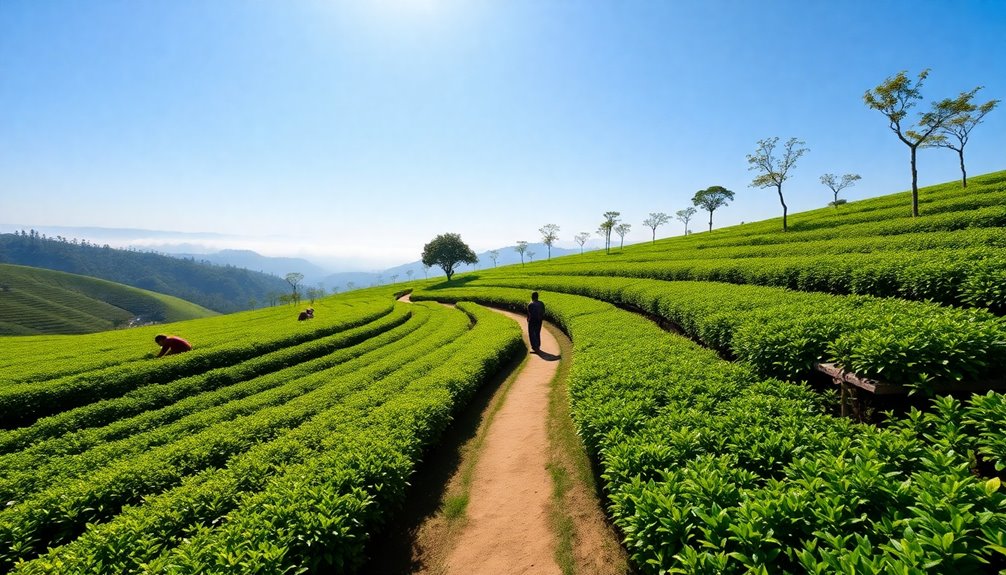
Exploring the practical applications of tea tourism can enhance your appreciation for India's tea culture while supporting local communities.
Imagine visiting Assam, the "Tea Capital of the World," where you can tour beautiful tea gardens like the Addabarie Tea Estate. You'll learn about black tea production during the harvest season from May to October.
In Darjeeling, you can visit Makaibari Tea Estate for guided tours showcasing different types of tea, including black, green, and oolong. The best time to visit is from March to November.
Don't miss India's first tea museum at Nallathanni Estate in Munnar, where you can explore the fascinating history of tea from August to May.
For a unique experience, head to Kolukkumalai Tea Estate, perched at 8,000 feet. You can enjoy authentic orthodox tea processing tours, accessible via jeep!
In Wayanad, eco-friendly accommodations at Parisons Plantation offer luxurious stays, exciting tea tours, and thrilling trekking opportunities.
These tea trails are more than just a visit; they're a delightful way to learn and taste the rich flavors of India's beloved beverage! Join in on this adventure and sip your way through India's tea heritage!
Frequently Asked Questions
Which Place Is Famous for Tea Plantation in India?
When you think of famous tea plantations in India, consider Assam for its robust black teas, Darjeeling for its floral aromas, or Munnar for its stunning landscapes. Each offers a unique tea experience you won't forget.
Which Place Is Best for Tea in India?
If you're looking for the best tea in India, consider Assam for its rich black tea or Darjeeling for its delicate flavors. Both regions offer unique experiences and are must-visit destinations for tea enthusiasts.
Which Is the Largest Tea Factory in India?
The largest tea factory in India is the Jorhat Tea Estate, located in Assam. It's renowned for producing high-quality black tea and utilizes both Orthodox and CTC methods to meet diverse market demands.
Which Hill Station in India Is Famous for Tea Gardens?
If you're looking for a hill station famous for tea gardens, Munnar is your best bet. Its stunning landscapes and lush plantations make it a perfect destination for tea lovers and nature enthusiasts alike.
Conclusion
Visiting tea plantations in India is an exciting adventure for everyone! You'll get to learn about tea's rich history, see how it's grown, and even taste different flavors. Plus, you can enjoy the beautiful scenery and fresh air with your family. Remember, it's important to support fair practices in these places too. So, pack your bags, grab your loved ones, and get ready for a fun-filled journey through India's amazing tea country! Happy exploring!

